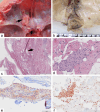Regression of multiple intracranial meningiomas after cessation of long-term synthetic progesterone (megestrol) medication: case report and autopsy
- PMID: 39473896
- PMCID: PMC11519963
- DOI: 10.17879/freeneuropathology-2024-5813
Regression of multiple intracranial meningiomas after cessation of long-term synthetic progesterone (megestrol) medication: case report and autopsy
Abstract
We report the history of a woman who developed four intracranial meningiomas during 11 years of therapy with the synthetic progesterone agonist megestrol. After discontinuation of the drug at age 75 years, she improved clinically and a CT scan showed near complete regression of the meningiomas by 78 years. Autopsy was performed at 83 years of age following an accidental death. At the tumor sites, we found both collagenous tissue with small islands of low grade meningioma having strong nuclear immunoreactivity for progesterone receptor and lipomatous tissue. A literature review showed similar cases of radiologic meningioma regression following discontinuance of progestins. Our case is the first one with histopathologic characterization of the end point.
Keywords: Autopsy; Megestrol; Meningioma; Progesterone receptor; Tumor involution.
Conflict of interest statement
The authors have no conflicts of interest to report.
Figures



Similar articles
-
Intracranial meningiomas in patients with uterine sarcoma treated with long-term megestrol acetate therapy.World Neurosurg. 2011 Nov;76(5):477.e16-20. doi: 10.1016/j.wneu.2011.03.035. World Neurosurg. 2011. PMID: 22152580
-
Regression of multiple intracranial meningiomas after cessation of long-term progesterone agonist therapy.J Neurosurg. 2010 May;112(5):920-4. doi: 10.3171/2009.8.JNS09201. J Neurosurg. 2010. PMID: 19731987
-
Multiple meningiomas arising during long-term therapy with the progesterone agonist megestrol acetate. Case report.J Neurosurg. 2004 Feb;100(2):328-31. doi: 10.3171/jns.2004.100.2.0328. J Neurosurg. 2004. PMID: 15086241
-
Secondary intracranial meningiomas after high-dose cranial irradiation: report of five cases and review of the literature.Int J Radiat Oncol Biol Phys. 2000 Aug 1;48(1):65-73. doi: 10.1016/s0360-3016(00)00609-x. Int J Radiat Oncol Biol Phys. 2000. PMID: 10924973 Review.
-
Association of breast cancer and meningioma. Report of 12 new cases and review of the literature.Pathol Res Pract. 1993 May;189(4):399-404. doi: 10.1016/s0344-0338(11)80326-2. Pathol Res Pract. 1993. PMID: 8351240 Review.
Cited by
-
Oral contraceptives with progestogens desogestrel or levonorgestrel and risk of intracranial meningioma: national case-control study.BMJ. 2025 Jun 11;389:e083981. doi: 10.1136/bmj-2024-083981. BMJ. 2025. PMID: 40500141 Free PMC article.
References
LinkOut - more resources
Full Text Sources
Research Materials
